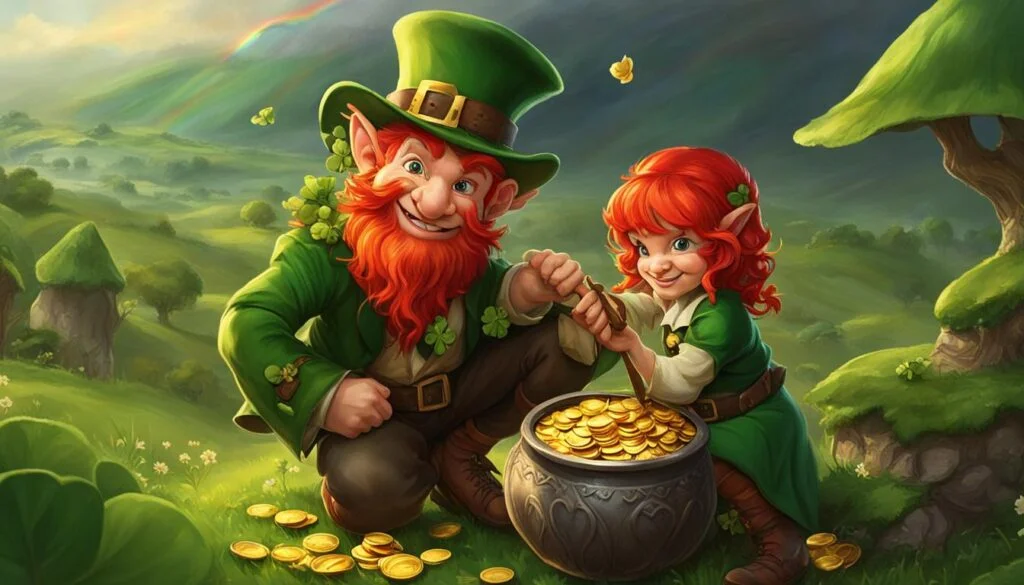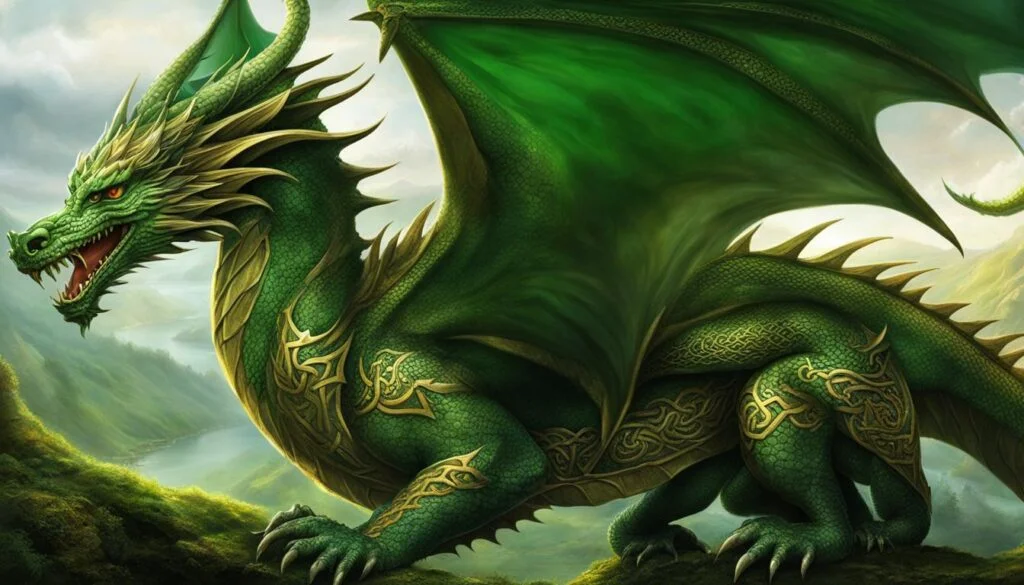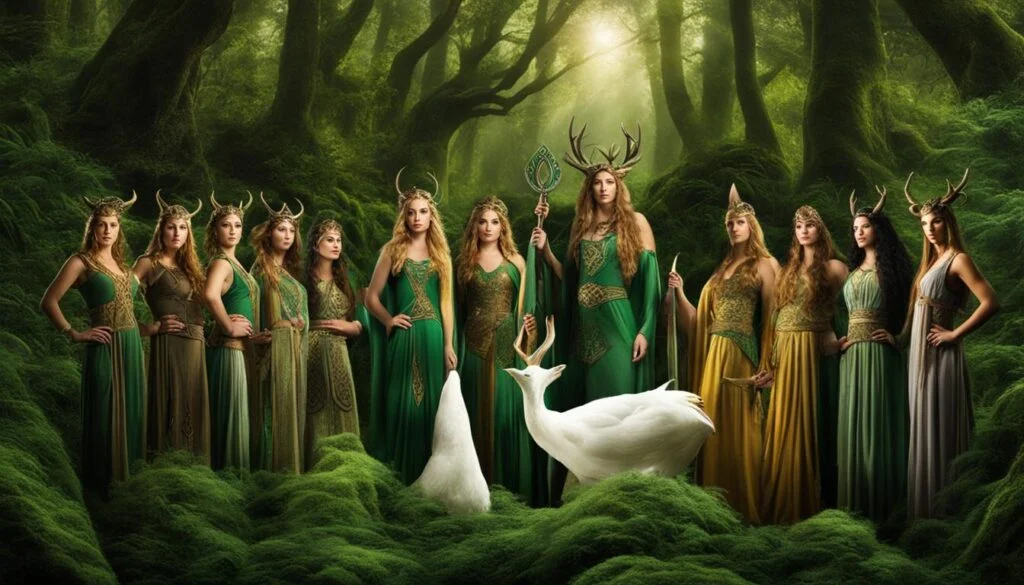Leprechauns, those mischievous little creatures from Irish mythology, have captivated people’s imaginations for centuries.
Legends of leprechauns have been passed down through generations, showcasing their supernatural abilities and connection to wealth.
These mythical beings are deeply rooted in Celtic folklore and play a significant role in Irish mythology.
In Irish folklore, leprechauns are often depicted as small old men dressed in either a red or green coat. They are known for their craftsmanship as shoemakers and their habit of hiding gold coins in a pot at the end of a rainbow. Capturing a leprechaun is said to grant three wishes, but only if the captor sets them free.
Despite their reputation for trickery, the myth of the pot of gold hidden at the end of the rainbow persists.
The origins of leprechauns can be traced back to the tales of water spirits known as “luchorpán” in the 8th century.
These spirits merged with household fairies and evolved into the leprechauns we know today. The term “leprechaun” itself comes from the Irish term “leath brogan,” which means shoemaker.
Over time, leprechauns have become an iconic symbol of Irish folklore and have made their way into popular culture.
They have inspired movies, including the horror-comedy series starring Warwick Davis, and serve as the mascot for Notre Dame.
Leprechauns have even become associated with a popular cereal brand, Lucky Charms.
While leprechauns continue to fascinate and entertain, it is important to approach their stories with amusement rather than reinforcing stereotypes.
These mythical creatures remind us of the cautionary tale against greed and the pursuit of quick riches.
Key Takeaways:
- Leprechauns are mythical creatures deeply rooted in Celtic folklore and Irish mythology.
- They are often depicted as mischievous old men in red or green coats, known for their craftsmanship as shoemakers.
- Legends of leprechauns often mention their association with hiding gold coins in a pot at the end of a rainbow.
- These mythical beings have become iconic symbols of Irish culture, appearing in movies, as mascots, and in popular cereal brands.
- The tales of leprechauns serve as cautionary reminders against greed and the pursuit of quick riches.
The Origins of Leprechauns in Celtic Folklore
The origins of Leprechauns can be traced back to Irish mythology. The term “Leprechaun” comes from the Irish term “leath brogan,” which means shoemaker.
The legend of Leprechauns can be linked to the tales of water spirits known as “luchorpán” in the 8th century.
These spirits merged with a household fairy and developed a fondness for heavy drinking.
Leprechauns are often depicted as shoemakers and are associated with the Irish tradition of hiding gold coins in a pot at the end of a rainbow.
The Myth of the Pot of Gold
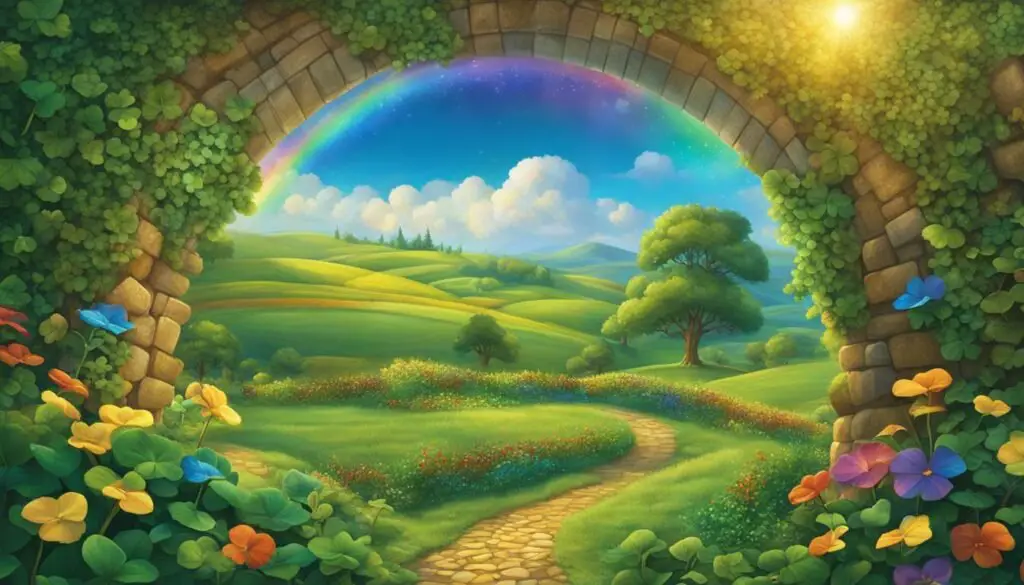
One of the most famous myths about Leprechauns is their association with pots of gold.
According to legend, Leprechauns find gold coins and store them in a pot hidden at the end of a rainbow.
The reason for their affinity with gold remains unclear, as they cannot actually spend it.
Some researchers suggest that the pot of gold is used to deceive humans, reflecting the Leprechauns’ penchant for trickery.
In Irish folklore, Leprechauns are often depicted as rogue characters who deceive and outsmart humans, using their greed against them.
The allure of wealth and the promise of finding a pot of gold at the end of the rainbow entice many to embark on an elusive quest.
However, like the Leprechauns themselves, the pot of gold remains just out of reach, a tantalizing dream that keeps the myth alive.
To further enhance their trickery, Leprechauns are said to use their wit and cleverness to confuse and misdirect those who seek their fortune.
They are masters of illusion and can create elaborate traps and riddles to guard their coveted treasure.
The pursuit of the pot of gold becomes a test of wit and determination, often resulting in disappointment.
While the pot of gold may be a purely mythical concept, it has become deeply ingrained in popular culture and serves as a symbol of wealth and prosperity.
From St. Patrick’s Day decorations to lucky charms, the pot of gold embodies the allure of fortune and the potential rewards that come with it.
Whether the pot of gold is real or not, the myth continues to captivate our imagination and reminds us of the age-old fascination with wealth and the lure of the unknown.
Leprechauns in Popular Culture
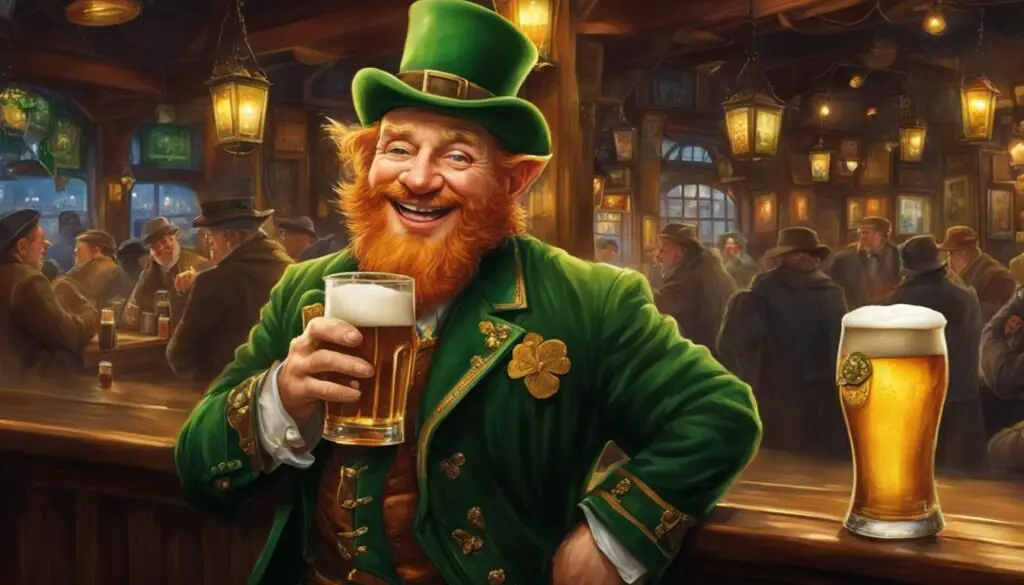
Leprechauns have captured the imaginations of people worldwide and have become an iconic symbol in popular culture.
These mischievous creatures, often associated with Ireland, can be found in various forms of media and entertainment.
Let’s take a closer look at some of the ways Leprechauns have made their mark.
Notre Dame Mascot
In the realm of sports, Leprechauns have found a prominent role as the beloved mascot of the University of Notre Dame.
This iconic figure, known as the Fighting Irish Leprechaun, represents the spirit and heritage of the university’s athletic programs.
Lucky Charms
Another well-known representation of Leprechauns can be found in the popular cereal brand, Lucky Charms.
This magically delicious breakfast cereal features a Leprechaun named Lucky as its playful mascot, who aims to protect his pot of gold from those who are after his lucky charms.
Leprechaun Movies
Leprechauns have even had their fair share of appearances on the silver screen, with a series of horror movies centered around these mythical creatures.
Starring Warwick Davis, these films offer a more sinister and frightening portrayal of Leprechauns, showcasing their notorious trickery and supernatural powers.
While Leprechauns in popular culture can sometimes perpetuate ethnic stereotypes, it’s important to remember that these depictions often carry moral messages.
They caution against the allure of “get rich quick” schemes and remind us of the perils of greed. Leprechauns continue to be a fascinating and enduring part of our cultural landscape, inviting us to explore the rich mythology of Ireland and embrace the whimsical tales they inspire.
The Evolution of Leprechaun Depictions
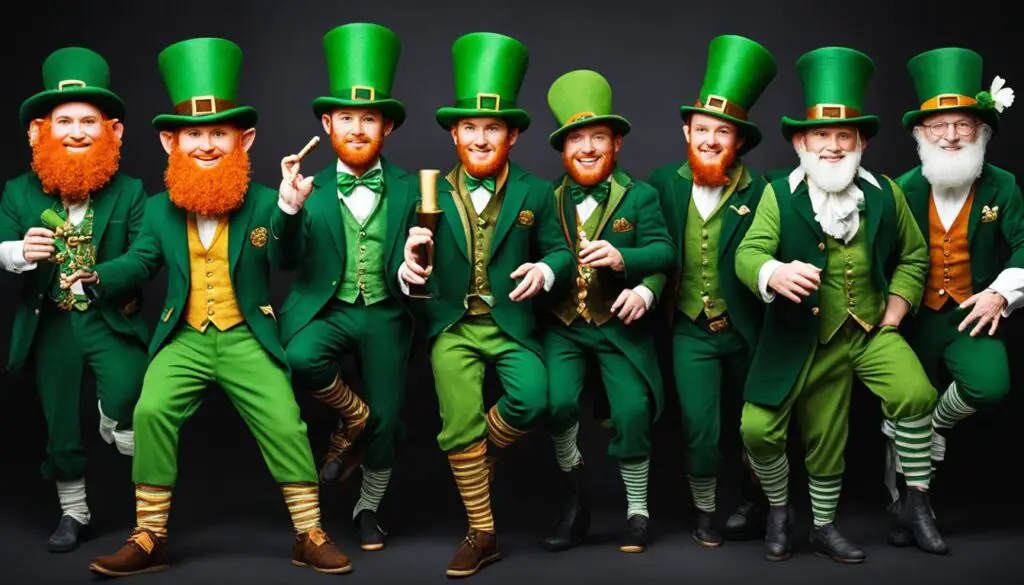
When we think of Leprechauns, the image that often comes to mind is a mischievous little creature dressed entirely in green. However, this modern-day depiction differs from the traditional Irish folklore, where Leprechauns were described as men wearing red outfits and tricorn hats. Renowned Irish novelist Samuel Lover captured this distinct portrayal in his 1831 work, Legends and Stories of Ireland.
While there is no record of female Leprechauns, Carolyn White’s A History of Irish Fairies offers an intriguing theory. According to the book, Leprechauns may be deformed children of fairies, defying typical biological laws. This unconventional origin adds another layer of mystique to these elusive creatures.
In contemporary culture, Leprechaun depictions have become iconic, with their green outfits symbolizing Irish folklore and mythology. However, it is interesting to explore the roots of these depictions and the variations that have emerged throughout history.
Evolution of Leprechaun Outfits:
- In traditional Irish folklore, Leprechauns were described as men dressed in red outfits and tricorn hats.
- Modern-day depictions portray Leprechauns dressed entirely in green, symbolizing their connection to Irish culture and heritage.
Samuel Lover and Leprechaun Depictions:
In his famous work, Legends and Stories of Ireland, Samuel Lover played a significant role in shaping the modern perception of Leprechauns. His vivid descriptions of red-clad Leprechauns have left a lasting impact on how we visualize these mythical creatures today.
Carolyn White’s Intriguing Theory:
Carolyn White’s A History of Irish Fairies provides an unconventional explanation for the origins of Leprechauns. According to her research, Leprechauns may be deformed children of fairies, challenging traditional biological conventions. This unique perspective adds an element of mystery and intrigue to the mythology surrounding Leprechauns.
Leprechaun Sightings and Legends
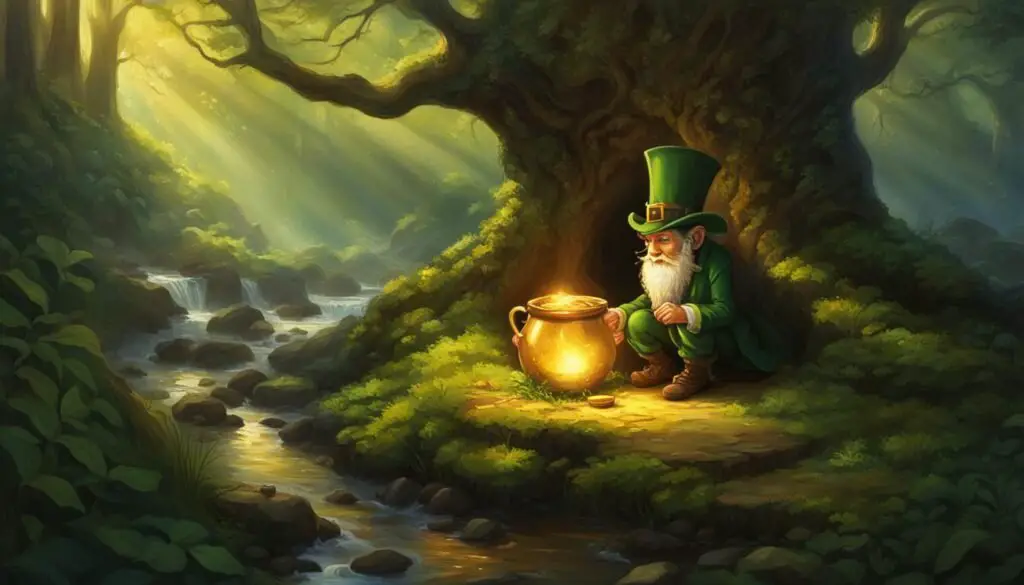
Over the years, there have been numerous reported sightings of Leprechauns, adding an air of mystery and intrigue to these mythical creatures. One particularly notable sighting took place in 1989 when P.J. O’Hare, a pub landlord in Carlingford, County Louth, claimed to have discovered the remains and clothing of a Leprechaun near a well. These artifacts now hold a place of honor on display in O’Hare’s pub, captivating visitors with their enchanting allure.
The enchantment of Carlingford does not end with O’Hare’s discovery. The picturesque Sliabh Foy Loop trail, nestled in the heart of Carlingford, is believed to be the habitat of an astounding 236 Leprechauns. To preserve and protect these magical creatures, the area has been designated as protected land under the European Habitats Directive. This landmark decision was made possible through the efforts of a local lobbying group, led by Kevin Woods, who successfully outlined the significance of safeguarding these elusive beings and their cultural heritage.
Carlingford’s reputation as a haven for Leprechauns continues to draw visitors from near and far, eager to catch a glimpse of these legendary creatures. The captivating allure of Leprechaun sightings fuels the imagination and serves as a testament to the enduring fascination with Irish folklore and the magical realms it encompasses.
The Fascination with Leprechauns in Carlingford:
- P.J. O’Hare’s discovery of Leprechaun remains
- Sliabh Foy Loop trail as the habitat of 236 Leprechauns
- Protected land under the European Habitats Directive
- Efforts of Kevin Woods and the local lobbying group
The Role of Leprechauns in Irish Folklore
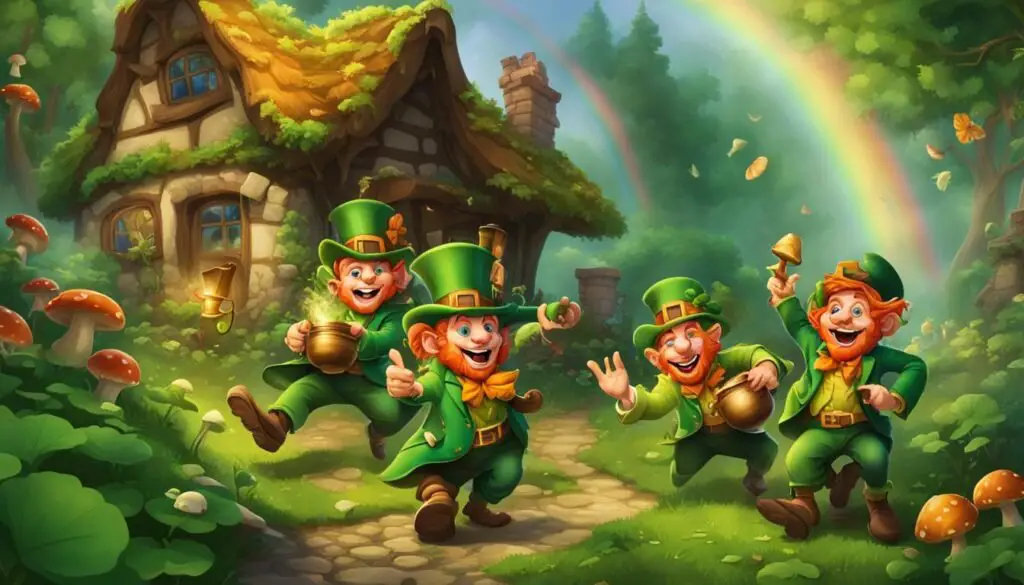
Leprechauns hold a significant place in Irish folklore, where they are widely regarded as cunning and trickery-filled supernatural beings. For centuries, these mythical creatures have been deeply ingrained in Irish culture and beliefs, capturing the imaginations of both locals and visitors alike.
Throughout history, the Irish have held strong beliefs about the power and presence of the “little people,” including Leprechauns. While they are often seen as mischievous figures, there exists an underlying fear that they can bring harm through their cunning nature. Irish folklore perpetuates the idea that Leprechauns are capable of playing cruel jokes and causing mischief for humans.
Leprechauns serve as a reflection of cultural attitudes ingrained in Irish society, shaping the belief in supernatural beings and their potential influence on people’s lives. Stories and legends portray Leprechauns as clever and crafty creatures, using their powers to navigate their way through elaborate tricks and schemes.
Despite their mischievous reputation, Leprechauns continue to be an important part of Irish folklore, enriching the cultural fabric of the country. They spark curiosity and intrigue, representing the mystical and enchanting elements of Irish mythology that have captivated generations.
The image below showcases the enduring allure of Leprechauns in Irish folklore:
Stay tuned for more fascinating insights into Leprechauns and their mythological significance in the upcoming sections.
The Mythological Significance of Leprechauns
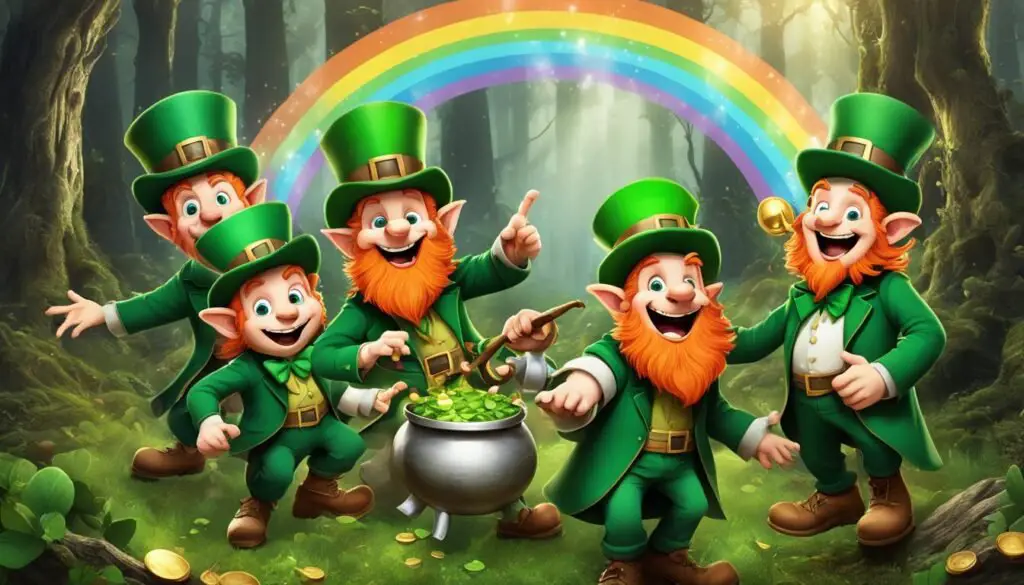
Many scholars believe that Leprechauns have their roots in pre-Christian Irish mythology. These mythical beings hold a significant place in Celtic folklore, embodying elements of wealth and trickery. The association of Leprechauns with wealth, particularly gold, can be traced back to the pre-Christian era when they were believed to be solitary nature spirits connected to the earth’s resources.
Their reputation as tricksters and their solitary nature reflect broader cultural beliefs and attitudes towards the supernatural. Leprechauns serve as cautionary figures, warning individuals against seeking quick riches and interfering with forces beyond their understanding.
Leprechauns in Popular Perception
Despite some irritation within the Irish community about the perpetuation of ethnic stereotypes, Leprechauns continue to fascinate and capture the imagination of people worldwide. The depiction of Leprechauns as mischievous tricksters or solitary hoarders of gold remains a beloved and enduring symbol of Ireland and its rich cultural heritage. The tales of Leprechauns should be taken with amusement and not to be taken too seriously.
The Fascination with Leprechauns
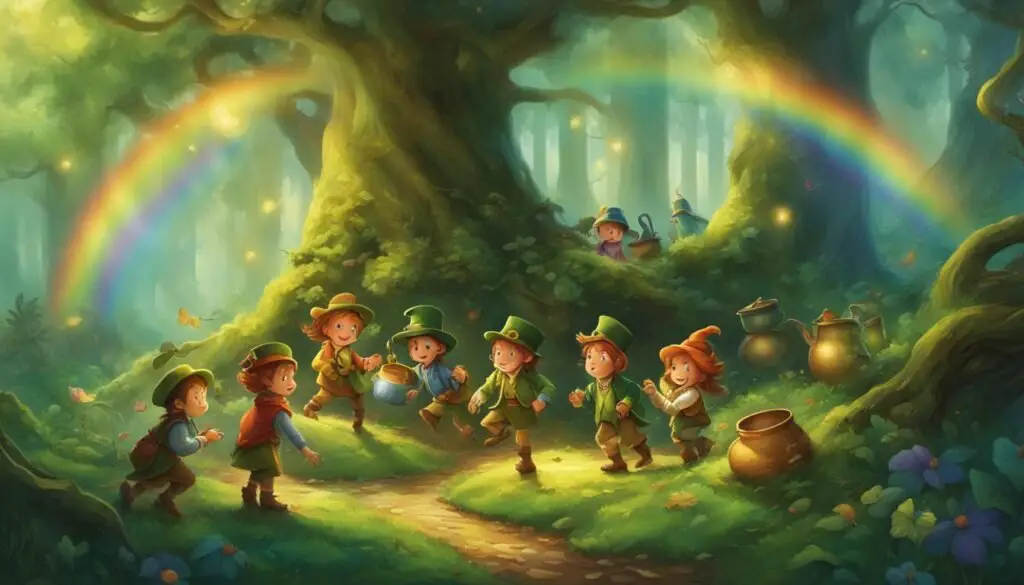
The fascination with Leprechauns continues to captivate modern society. People are drawn to the intriguing world of these mythical creatures and their connections to Irish folklore. To cater to this interest, Dublin boasts the renowned Leprechaun museum, offering immersive tours and providing detailed information about Leprechauns and their place in Irish mythology.
For those looking to delve even deeper into Leprechaun lore, various Irish-themed websites offer tips and tricks on how to catch a Leprechaun. Enthusiasts can explore age-old legends and learn about the rituals associated with these elusive beings. From crafting traps to deciphering Leprechaun language, these resources serve as a gateway to unraveling the mysteries surrounding these mischievous creatures.
Leprechauns have also become iconic figures in popular culture. General Mills cereal’s Lucky Charms, with its recognizable Leprechaun mascot, has become a beloved part of American breakfast traditions. Additionally, Leprechauns feature prominently in horror/comedy movies, playing on their mischievous nature and entertaining audiences with their antics.
Conclusion
Leprechauns, deeply rooted in Irish mythology and Celtic folklore, hold a significant mythological significance. These mythical beings are known for their association with wealth and their mischievous nature. Leprechauns continue to captivate people’s imaginations and serve as a symbol of Ireland’s rich cultural heritage.
While the portrayal of Leprechauns in popular culture may perpetuate stereotypes, it is important to approach their tales with amusement. They serve as cautionary tales, reminding us of the dangers of greed and “get rich quick” schemes.
Whether they are depicted in movies, cereal boxes, or stories passed down through generations, Leprechauns offer a glimpse into the fascinating world of Irish folklore and mythology. Their enduring charm and inherent mystery make them a beloved and iconic figure that continues to fascinate people around the world.
FAQ
What is the mythological significance of Leprechauns in Celtic folklore?
Leprechauns hold significant mythological significance in Celtic folklore. They are deeply rooted in Irish mythology and serve as mythical beings associated with wealth and trickery.
How are Leprechauns depicted in Irish folklore?
In Irish folklore, Leprechauns are often depicted as mischievous little creatures that take the form of an old man in a red or green coat. They are known for making shoes and hiding their gold coins in a pot of gold at the end of a rainbow.
What is the origin of Leprechauns in Celtic folklore?
The origins of Leprechauns can be traced back to Irish mythology. The term “Leprechaun” comes from the Irish term “leath brogan,” which means shoemaker. The legend of Leprechauns can be linked to the tales of water spirits known as “luchorpán” in the 8th century.
Why are Leprechauns associated with a pot of gold?
According to legend, Leprechauns find gold coins and store them in a pot hidden at the end of a rainbow. Some researchers suggest that the pot of gold is used to deceive humans, reflecting the Leprechauns’ penchant for trickery.
How are Leprechauns depicted in popular culture?
Leprechauns have become a cultural icon and tourist attraction, particularly for Americans. They are often associated with Ireland and feature in popular culture. The Leprechaun serves as the mascot for Notre Dame and is also the symbol of Lucky Charms cereal.
How have Leprechaun depictions evolved over time?
The modern-day depiction of Leprechauns often shows them dressed entirely in green. However, in traditional Irish folklore, they were described as men wearing red outfits and tricorn hats.
Have there been any reported sightings of Leprechauns?
There have been reported sightings of Leprechauns, including one in 1989 by a pub landlord named P.J. O’Hare in Carlingford, County Louth. O’Hare claims to have found the remains and clothing of a Leprechaun near a well, which are now displayed in his pub.
What is the role of Leprechauns in Irish folklore?
Leprechauns play a significant role in Irish folklore and are often associated with cunning and trickery. They are supernatural beings that have been deeply ingrained in Irish culture and beliefs.
What is the mythological significance of Leprechauns in Celtic folklore?
Many scholars believe that Leprechauns have their roots in pre-Christian Irish mythology. Their association with wealth, particularly gold, is reminiscent of the solitary nature spirits in early Irish folklore, who were believed to possess great wealth connected to the earth’s resources.
How are Leprechauns perceived in popular culture?
Despite some irritation within the Irish community about the perpetuation of ethnic stereotypes, Leprechauns continue to fascinate and capture the imagination of people worldwide. The tales of Leprechauns should be taken with amusement and not to be taken too seriously.
What is the fascination with Leprechauns in modern society?
The fascination with Leprechauns continues in modern society. There is a Leprechaun museum in Dublin that offers tours and detailed information about Leprechauns and Irish folklore. Leprechauns have become iconic figures in advertisements, such as General Mills cereal’s Lucky Charms. They also feature in horror/comedy movies that capitalize on the mischievous nature of these mythical creatures.


